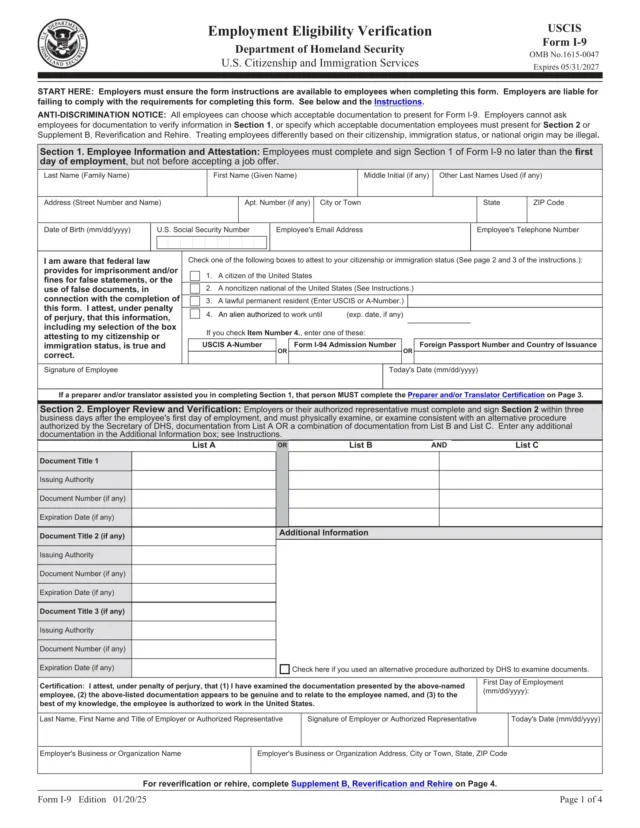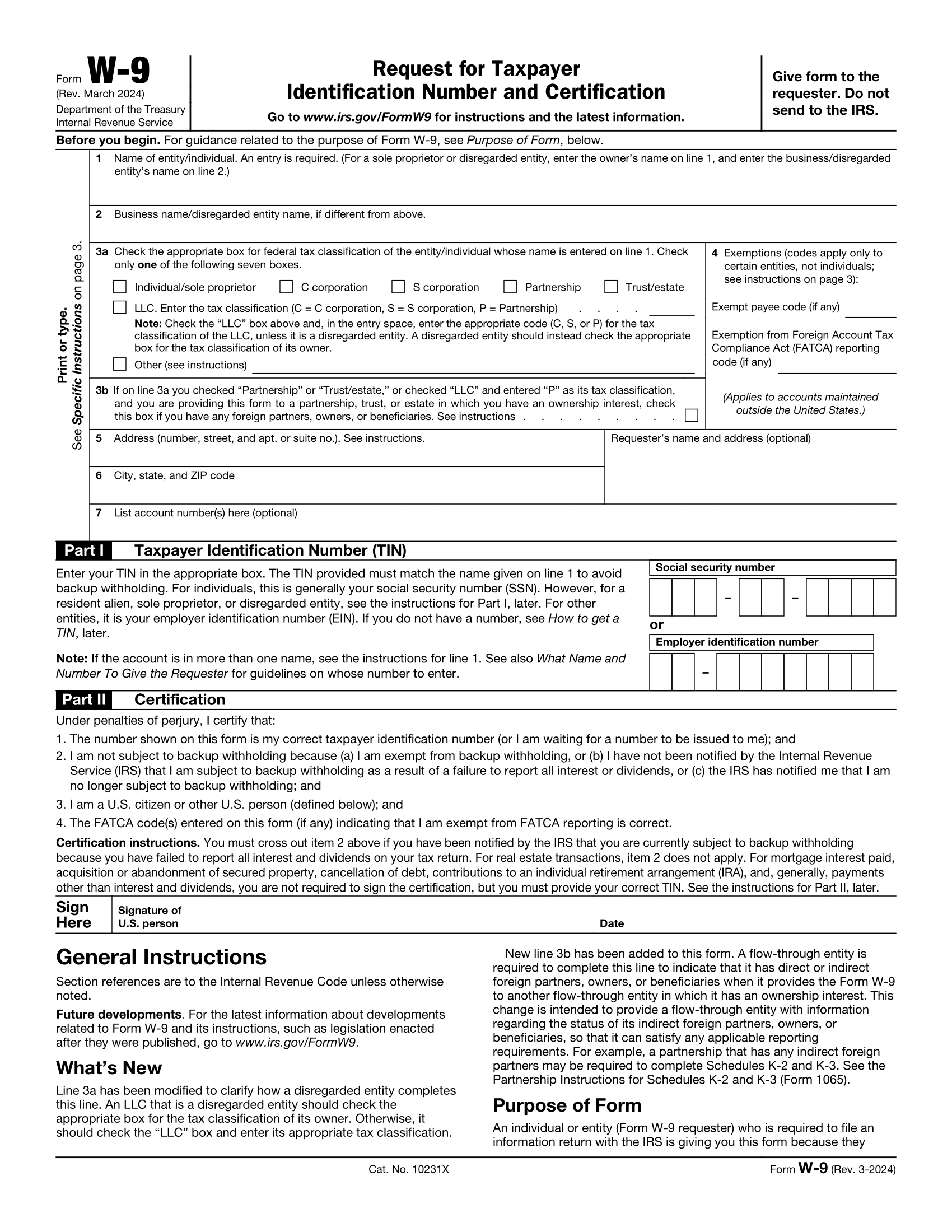What Is IRS Form W-9?
Form W-9, officially called the Request for Taxpayer Identification Number and Certificate, is a document the IRS uses to collect an individual’s tax ID number. This number is typically your Social Security Number (SSN) if you’re an individual, or your Employer Identification Number (EIN) if you’re filing for a business.
The person providing the form is referred to as the payee, and the person requesting it is the payer. You don’t send the W-9 form to the IRS. Instead, you give it to the person or company that requested it so they can report how much they paid you during the year.
Form W-9 is important because it helps businesses and financial institutions prepare other tax forms, such as the 1099-NEC. These forms show the income you earned throughout the year. Providing accurate information on your W-9 form ensures your income is reported correctly. It also reduces the risk of issues such as penalties, missed payments, or delays when filing your taxes.
Changes to W-9 Form for the 2025 Tax Season
The IRS released a new version of Form W-9 in March 2024, and these updates also apply to the 2025 tax year. These updates mainly affect LLCs, partnerships, and flow-through entities.
Simplified Instructions for LLC
If you’re a single-member LLC, the IRS now gives clear guidance on how to fill out the form:
- Line 1: Enter the owner’s name here
- Line 2: Enter your LLC’s name here
- Line 3(a): Select the owner’s tax classification (like individual, C-corp, or S-corp)
These updates help avoid confusion about how a disregarded entity should report its tax status (IRS W-9 Instructions (2024)).
If you’re a single-member LLC, you may also need an operating agreement to outline how your business is run. Legal Templates offers a free single-member LLC operating agreement template that you can use to help clarify your structure for legal and tax purposes.
New Question About Foreign Ownership
The IRS added a new checkbox on Line 3b of the W-9 form. This box is for partnerships, trusts, or estates (including LLCs taxed as partnerships) to indicate if they have any foreign owners, partners, or beneficiaries. This is particularly important for entities needing to comply with additional reporting requirements, such as completing Schedules K-2 and K-3 for partnerships with foreign partners.
If your business fits this description, you’ll need to check this box. This helps the requester understand your ownership structure and meet their own tax reporting requirements.
Who Needs to Fill Out a W-9 Form?
You may be asked to complete the IRS W-9 form when a business or individual needs your taxpayer identification number (TIN) to report payments made to you for tax purposes. You’ll likely need to fill out a W-9 form if you are:
- An independent contractor or freelancer: If you earn $600 or more from your services, the business paying you must report it on Form 1099-NEC.
- A vendor or service provider: Businesses hiring you to supply goods or services may request a W-9 to ensure accurate year-end reporting.
- A landlord or property owner: If a business pays you more than $600 to rent commercial space, they’ll typically issue a Form 1099-MISC.
- A shareholder or investor: If you receive dividends as a shareholder or other investment income, your broker or fund manager may need a W-9 form to issue Form 1099-DIV.
- A customer of a financial institution: Banks and lenders may ask for a W‑9 when you open a new account or investment that could earn taxable interest or dividends.
Not sure if you need a W‑9 or W‑4?
Use a W‑9 if you’re self-employed or working as a contractor. Use a W‑4 if you’re starting a new job as an employee. It tells your employer how much tax to withhold from your paycheck.
How to Fill Out IRS Form W-9 in 2025
Follow the steps below to fill out your IRS Form W-9 for 2025. You can also complete your W-9 form using Legal Templates’s free fillable IRS W-9 Form template for 2025 to save time and reduce mistakes.
Step 1 – Provide Your Contact Information
Begin by entering your full name on Line 1. If you own a business or work under a different name, write that in Line 2. Use Lines 5 and 6 to fill in your street address, city, state, and ZIP code. This is where the requester may send tax forms, such as the 1099-NEC.
Sole proprietors and disregarded entities should list the owner’s name on Line 1 and the business name on Line 2, if the names differ.
Step 2 – Choose Your Tax Classification
In Line 3, select your federal tax classification. Common choices include:
- Individual / Sole Proprietor
- C Corp
- S Corp
- Partnership
- Trust or estate
- Limited Liability Company (LLC)
If your business is an LLC, only check the box if you’ve elected to be taxed as a corporation or partnership. If not, the IRS will treat your LLC as part of your personal taxes. Also, if you’re a partnership, trust, or LLC with any foreign owners or beneficiaries, you’ll need to check the new box on Line 3.
Step 3 – Add Exemptions (If Any)
If you are exempt from backup withholding or the Foreign Account Tax Compliance Act (FACTA), list the appropriate exemption code in this section. Exempt payee codes are only applicable to specific entities, not individuals.
Step 4 – Fill In Optional Information
Form W-9 contains two optional fields:
- Requester’s name and address: Helps the requester track your form
- Account numbers(s): Useful if the business works with you under multiple accounts
These are not required, but they can help avoid confusion, especially when working with multiple payers.
Step 5 – Enter Your Taxpayer Identification Number (TIN)
In Part 1, provide your Social Security number (SSN) if you’re an individual. If you’re filing as a business, then list your Employer Identification Number (EIN). If you’ve applied for an SSN, ITIN, or EIN but don’t have it yet, write “Applied For” to indicate that.
Step 6 – Certify and Sign the Form
Part II contains a short certification for payees to read. Ensure you agree with all four statements before signing and retain a copy for your records. You’ll need to confirm that:
- The TIN you provided is correct
- You’re not subject to backup withholding (or you’re exempt)
- You’re a US person or business
- You’re exempt from FATCA (if you entered a code)
Do I Always Need to Sign a W-9?
You typically need to sign your W-9, but there are exceptions, such as when the W-9 is used for transactions like debt cancellation or settlement. However, you will still need to provide an accurate TIN.
Penalties and Legal Considerations for Form W-9
Failing to complete the W-9 form correctly can result in fines and tax issues for both the payee and the payer. Here’s what you need to watch out for:
24% Backup Withholding
If you don’t return a completed Form W-9 when asked, the payer must withhold 24% of any future payments. This is called backup withholding. This rule also applies if you give an incorrect or missing TIN (taxpayer identification number). Backup withholding usually affects payments like:
- Freelance or contract work
- Rent or royalty payments
- Interest and dividends
If you’re waiting on an SSN, EIN, or ITIN, you should provide it as soon as possible to stop the withholding.
$500 Penalty for False Information
If you provide false information on your W-9 form, like a wrong name or TIN, and avoid backup withholding, the IRS may charge you a $500 fine. In more serious cases, knowingly providing false information can also lead to criminal charges.
Payer Penalties for Missing W-9s
If you’re a payer and you don’t collect a completed W-9 form, you may face fines for filing late or incorrect 1099 forms. These penalties can range from $60 to $330 per form, depending on the lateness of your filing (IRS – Instructions for the Requester of Form W-9). To stay compliant, make sure you:
- Ask for a W-9 form before making payments
- Check that it’s complete and accurate
- Use the information to prepare year-end 1099 forms
Confirm TINs Before Filing
Use the IRS TIN Matching Program to make sure a payee’s name and TIN match. This helps you avoid 1099 errors and IRS penalties.
Sample IRS W-9 Form
Below, you’ll find a sample IRS W-9 form that shows how to complete each section with the correct personal and tax details. Use Legal Templates’s fillable 2025 IRS W-9 form to complete it online, then save a copy to share with the requester. You can also get a printable W-9 for your records.





